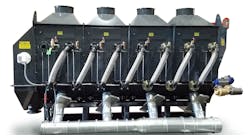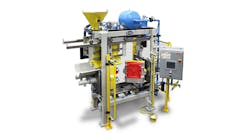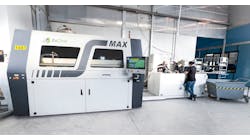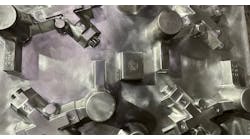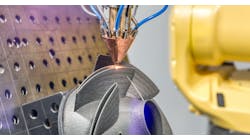Only those foundries that improve overall productivity faster than do their competitors will prosper as the economy revives. Best defined as units of output compared to units of asset inputs -- labor, capital, managerial skills, and/or better technology – overall productivity has been relatively flat over the last 24 years, says the Bureau of Labor Statistics. (See chart.)
Overall productivity improved an average of 1.3% annually over from 1987 to 2011, the most recent year for which statistics are available. According to the BLS, productivity fell 1.4% annually during the 2007-2009, and then dropped another 2.3 % annually during the next two years. This no doubt reflects the market slump during the Great Recession, foot-dragging of ops managers worried about losing skilled employees, and finally the reluctance of foundries to cut office overhead in slack times.
Perhaps this lackluster growth in overall productivity explains why imports took a growing share of the U.S. metalcasting industry's markets in recent decades. But, as foreign labor costs and prices increase, domestic casting buyers are “reshoring” their purchases; the price differential between American and foreign castings has shrunk enough that dealing with suppliers 8,000 miles away is an unnecessary headache.
Before I paint too rosy a picture of the future, let's look at two snapshots of today. First, major casting customers – automotive alone takes about one third of all ferrous castings and nearly half the nonferrous diecastings produced -- are reviving. With their recovery, metalcasters’ orders have grown. Since a rising tide lifts all boats, higher overall demand for castings has meant even inefficient foundries have strong order books.
Now, because of this scenario, a second picture comes into focus. That is, most foundry executives are so busy dealing with new orders and putting out daily fires that they have little time to consider their long-term needs of boosting their own overall productivity and enhancing their own market competitiveness. As Ford Motor’s Chairman Bill Ford said recently, ‘I’ve learned you have to go faster and bet bigger when you are doing well,’” (Ramsey, Mike, “Fuel Goal Tests Ford’s Mettle,” Wall Street Journal, 13 Jan, 2014, pg. B1)
Foundry executives looking beyond tomorrow know there are four ways to “bet bigger”: boost worker productivity, increase supervisory efficiency, improve managerial effectiveness, or invest in new equipment. The first three can be mastered with a modest investment, a relatively small expenditure of time, and a willingness to challenge the status quo before it becomes the status woe. The last takes credit, and banks are still reluctant to lend. But altogether, these four ways will result in lower per-unit costs and the ability to compete successfully in the future the economy continues its lurching climb.
Let's start at the simplest and fastest to accomplish, and move to the complex.
Employees and Employee Productivity
The simplest way to boost employee productivity is by creating incentive systems to motivate them to work smarter, and if needed harder, to increase their output.
Most workers want to do a good job, be productive … and be rewarded for their efforts. When a reward system like Gainsharing is implemented by an expert with enough foundry industry experience, history shows that productivity will improve from 17 to 22%.
But how to measure their productivity? While many executives worry about improving productivity, few do an adequate job of measuring it. Most settle for a simple figure -- sales dollars per man-hour worked, even though they make a wide mix of castings whose fluctuating prices depend more on competition than anything else. In my experience, few casting executives, especially those in smaller foundries (65% have fewer than 100 employees, says Foundry Management & Technology’s 2014 Outlook) devote enough time formulating understandable productivity measures to communicate to employees, or to developing effective incentives to motivate them to strive for the continuous productivity improvement needed to please today’s price-conscious customers.
A simple measure of productivity is pounds or tons of good castings produced per man-hour worked. That can be measured in terms of direct labor, overall plant labor, or office and plant employees, and is easily understood by all. Obviously, pounds of castings per hour worked is a crude definition, but it is understandable. Corrections can be made for the types of castings produced, i.e., heavy manhole covers require relatively little grinding and are low priced compared to decorative thin-wall castings for lawn furniture frames, which command higher prices but need a lot of detailed work in finishing. But, once the corrections are made -- and they ought to include the type of metal cast, average order size, or pricing -- foundry executives have a simple, effective measure that is easily communicated and understood.
The latter is important, because foundries wishing to improve employee productivity must provide understandable benchmarks for employees to shoot for, as well as rewards for exceeding them. Surveys tell us employees tire of lunches quite quickly.
Astute foundry managers include their entire workforce in their calculations. By factoring in all employees -- supervision, quality and technical support, and/or office workers -- casting executives can quickly determine their effect on overall productivity and bottom-line profitability. Whether to hire another maintenance man or additional office staffer becomes an easier decision.
Supervisory Efficiency
There are two reasons that few foundries measure supervisory efficiency or the effectiveness of their managers or make many efforts to improve either. First, it is usually difficult to measure results, and second, inertia. Blaming "lazy" workers for mediocre productivity is easier than upsetting long-term supervisors and mid-managers who are set in their ways. For most foundries, especially the smaller ones, "good enough is often good enough," if a modest profit is made.
Those that try to upgrade their supervisors often buy inexpensive training programs from the internet or a trade association. While these generalized courses might help new, bewildered "newbie" supervisors, they give the more experienced ones inured to the inevitable little reason for change. Moreover, most canned training aims at helping supervisors manage the behavior of their subordinates, rather than showing them how to manage the work of their subordinates. Teaching supervisors how to deal with sassy employees is fine, but does little for productivity. Constraint theory, real-time scheduling to coordinate castings from pour-floor through finishing, does. After all, isn't improving departmental efficiency the reason that supervisors are paid?
These deficiencies can be rectified by retaining a knowledgeable trainer who takes the time to understand existing supervisory practices and attitudes before making recommendations to improve them. This understanding can be accomplished by interviewing supervisors to determine how they perceive their work environment and then talking with mid-managers to obtain an overall view of how operations actually run. Only then can realistic plans be made about the training content; how to set proper goals to measure its effectiveness; how to conduct the sessions with enough pizazz to keep even the most jaded of supervisors awake; and finally, how to measure the results over time and communicate them back to the supervisors in question.
Management Effectiveness
Improving managerial skills by development efforts is a fraught subject. The critical skill most managers need is making better use of their time, their scarcest resource. Managerial effectiveness can be improved by helping individual managers define their key objectives and then teaching them how to focus their time on those, leaving the hum-drum to subordinates.
Again, the first step is for a knowledgeable expert to interview a foundry's executives to uncover how they see the problems, and then to check with mid-managers to validate their concerns. Then, effective training can be designed based on reality. This is a more effective than merely inflicting upon unsuspecting managers lists of KPIs (Key Performance Indicators) and then expecting them somehow to shine.
Effective training then begins by helping individual managers set key goals, obviously, with in-put from upstairs. After managers are asked to demonstrate just how they actually spend their time, they can be shown objectively where they are spinning their wheels and when they are devoting their time to the most worth-while activities that contribute the most to their key goals. Managers can be shown how much each of their activities contributes to all of their goals. Then, managers can be shown how all their activities contribute to each of their specific goals. Once internalized and re-enforced, managers will use their time to their maximum advantage -- as well as to their company’s.
The final way to improve overall productivity is to substitute capital for labor, a trend that started the Industrial Revolution centuries ago. Again, in my experience, few executives -- especially those in smaller foundries – have ever asked themselves what return on capital they want before investing in new equipment or "better" technology.
Let's say a new automatic molding machine with a core setter costing $500,000 will speed production and the owner needs a 25% initial return on his funds. He then needs to ask if the $500,000 its costs will result in $125,000 in annual labor savings – coremaking and maintenance. Obviously, depreciation schedules and other tax issues complicate things, but that keeps accountants and tax attorneys out of trouble. More complicated is figuring the return on changing the plant layout to streamline production or implementing an ERP system to monitor work flow. The results of such changes are often overestimated by gung-ho managers for two reasons: first, because many need a stronger shot of reality in their morning coffee, and second, because little effort is made to include employees in the decisions. As a result, workers see new equipment and processes as simple head-chopping exercises and find subtle ways to torpedo them in real life. Luddites lurk everywhere.
All Together Now
One can easily sympathize with the executives of smaller casting companies who constantly juggle the daily realities of maintenance breakdowns, porosity problems, lame supervisors, ineffective managers, and customer demands for lower prices and last minute schedule changes. These are the eternal nature of the casting business. Customers might not always be right … they are customers. There are too few of them and too many competitors willing to put up with their transgressions.
Other problems are self-inflicted. Harried executives are often so immersed with the concrete day-to-day problems of juggling customer demands that they delay challenging the inertia within their own companies. This long-term threat to their own future can be overcome by dealing with subordinates openly and honestly: by rewarding outstanding performers and sanctioning mediocre ones at all levels; by showing managers how to function with high effectiveness; by providing supervisors with the training needed to run their departments with measured efficiency; and by implementing incentive systems like Gainsharing for better productivity at the lower levels.
Because if executives like you don’t do it, your competitors will be the ones who catch the bridal bouquets.
Dr. Imberman is president of Imberman and DeForest Inc., management consultants specializing in improving managerial effectiveness, supervisory efficiency, and employee productivity through management and supervisory training, workforce audits, Gainsharing Plans, and other pay-for-performance programs. He has written numerous articles on these subjects.
Contact him at [email protected]. or tel. 847-733-0071 for additional information or his previous FMT reports.




